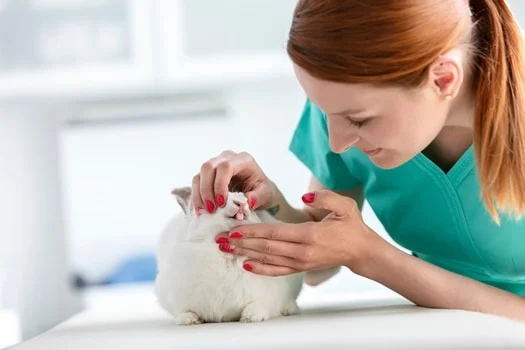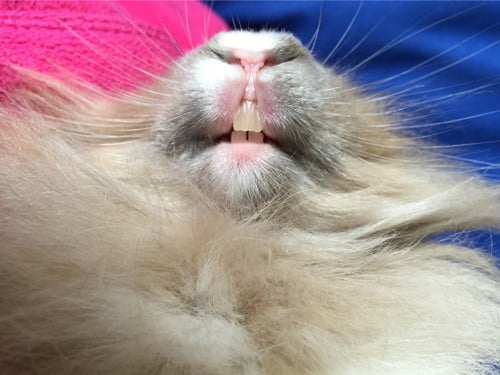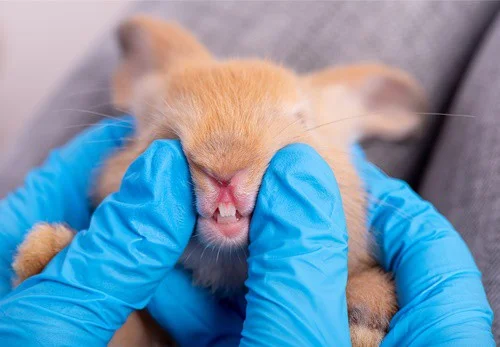Rabbit teeth should be bright white, but may become discolored. This must be managed and prevented. Yellow, brown, or black discoloration is a warning that your rabbit’s teeth aren’t healthy.
A diet of fresh timothy should make up 90% of a rabbit’s diet, as it files down discolored ends. Remove fresh vegetables and pellets until your pet’s teeth are white again. If your rabbit’s teeth remain discolored, they’ll need to be professionally trimmed.
It’s possible that discoloration of rabbit teeth is temporary staining. If your rabbit eats something colorful, it may stain her teeth. If this is the case, they’ll return to white. If the discoloration appears more permanent, it should be corrected or your pet is at risk of losing her teeth.
What Should Healthy Rabbit Teeth Look Like?
A rabbit’s main teeth are called incisors. These are the four front teeth that give rabbits their distinct appearance. Rabbits have six incisors. Two additional tiny teeth are hidden in the upper mouth. These are called peg teeth.
Rabbits have more teeth that we can see. The average rabbit has eleven molars, which are hidden inside bones. Six of these molars are in your rabbit’s upper mouth, and five in the lower.
Your rabbit should always be able to close her mouth without her teeth overlapping. Her teeth should also be straight. Ensure your pet eats plenty of hay.
What Color Should Rabbit’s Teeth Be?
Look out for is the color of your pet’s teeth. Rabbit teeth should be bright white. Any form of discoloration is bad news. It suggests that your pet will experience dental pain, if she isn’t already.
It’s possible for a rabbit’s teeth to be temporarily stained by food. If you gave your rabbit strawberries, she might have red teeth for a while. Overall though, rabbit teeth should be bright white – or at the very least, pale cream.
It should be simple to tell the difference between staining and discoloration. Just inspect your rabbit’s teeth regularly. An overnight change in color is usually temporary staining. A gradual descent into discoloration is more concerning.
How to Check a Rabbit’s Teeth for Discoloration
Checking a rabbit’s teeth is important, but most rabbits will not enjoy the experience. Your pet may make it difficult for you to get a good look at her teeth.
This is because rabbits use their teeth as a defense mechanism. If a rabbit feels threatened, she’ll bite and nip. If you take this mode of defense away, your rabbit feels vulnerable.

To check your pet’s teeth without causing her undue stress, follow these steps.
- Pet your rabbit until she enters a state of blissful calm.
- Start to stroke around your rabbit’s mouth, so she is used to being touched here.
- If your rabbit reacts poorly, stop here for now. Try again later. Eventually, your rabbit will start to trust you when you touch her mouth.
- When she allows you to, gently lift your rabbit’s upper lip. Do not force her to open her mouth. You will not be able to see her molars anyway.
- Look at your rabbit’s upper incisors. Ensure they are clean and straight.
- Take a look at your rabbit’s gums. These should be pink. Bright red or purple shades are warning signs of gum disease.
- Repeat this process with your rabbit’s bottom incisors.
- Offer your rabbit a favorite treat. This will help you in the future. Your pet will tolerate tooth inspections if you make them worth her while.
If you do notice discoloration, make a note of the color and check again in 24 hours. If it was temporary staining, you have nothing to worry about.
Are Discolored Teeth in Rabbits Caused by Gum Disease?
Gum disease precedes discolored teeth. Foul breath is the first warning sign of this. The gum disease will then attack the teeth. In rabbits, it’s often the other way around.
Because rabbit teeth never stop growing, they’ll grow into the gum if not trimmed. This can puncture the gums, leading to bleeding and open wounds. This, in turn, invites bacteria into the mouth.
Once your rabbit has live bacteria in her mouth, her teeth will suffer. She’ll potentially lose enamel, and expose the root. This leads to discoloration, though aesthetics are the least of your pet’s concerns. Gum disease can lead to the rabbit losing teeth.
Why Are My Rabbit’s Teeth Yellow?
If your rabbit often has temporary yellow stains on her teeth, clean her hutch more often. She may be urinating on her hay then eating it.
If your pet’s teeth are gradually yellowing, they are not being trimmed sufficiently. Yellow discoloration creeps in as a rabbit’s teeth grow longer. As rabbit teeth never stop growing, this will become problematic.
Watch your rabbit’s eating habits if her teeth are yellowing. If she is rejecting hay in favor of pellets, remove the latter from her hutch. Hay is critical to keeping a rabbit’s teeth clean and trim.
This is due to the fiber content found in hay. It takes a rabbit a while to chew through this foodstuff. As a result, every tooth in her mouth will be organically filed down. Pellets are softer, and do not provide the same benefits.
You may need to get creative to convince your rabbit to eat hay again. If her teeth are yellow, she may already be experiencing some mild dental pain. This would explain why she turned against hay in the first place.
Try sprinkling a little alfalfa hay in with timothy hay. Just a little – the ratio should be 90/10 in favor of timothy hay. This will tempt your rabbit to eat, as alfalfa is what pellets are made of. It will be a comforting and familiar taste. This will get her started. She can them move into timothy hay.
Alfalfa hay alone is bad for a rabbit’s health. It’s full of protein and calcium, and holds little fiber. Alfalfa hay will not help your rabbit in the longer term. She needs timothy hay for healthy teeth.
Why Are My Rabbit’s Teeth Brown?
Brown staining on your rabbit’s teeth is common. This is because rabbits eat their own feces. This may sound unappealing, but it’s natural rabbit behavior. Your pet gets nutrients from her droppings.
If the staining is not temporary, it suggests something considerably more concerning. Your rabbit’s teeth are growing quickly, and the root is becoming exposed. This will be every bit as painful as it sounds. Your rabbit will not be able to eat or drink without severe pain. It also increases the risk and likelihood of gum disease.
It may be possible that trimming it down can save the tooth. It’s likelier that the tooth will need to be removed entirely, though. This will prevent any spread of disease.
Tooth removal isn’t a decision to be made lightly. Thankfully, rabbits can cope without incisors. You’ll need to chop your pet’s fresh food into smaller chunks.
Why Are My Rabbit’s Teeth Black?
Black teeth in rabbits are a medical emergency. This symptom suggests that your rabbit has lost the enamel from her teeth. An infection will invariably follow, alongside significant pain and stress.
Your rabbit will likely need to have these teeth removed. Ignoring the problem will only aggravate it. Your rabbit’s health concerns could escalate drastically if black teeth are not treated.
A rabbit will rarely develop black teeth overnight. With regular inspections, you should be able to see the issue coming. This means that you’ll have time to prevent it from getting any worse.
If you notice black stains on your rabbit’s teeth, cut down her sugar intake. Most rabbits have a sweet tooth. This means your pet will adore sugary fruits and vegetables as treats. These will remove enamel from her teeth, though.
You’ll need to be vigilant about cutting these treats. Get your pet on a strict diet of hay alone, at least for a while. As her teeth grow, they may repair themselves. If that’s the case, you can reintroduce sweet treats in moderation.
How to Remove Discoloration from a Rabbit’s Teeth
If your rabbit does have discolored teeth, attempt treatment at home. Start by removing pellets and fresh food from your rabbit’s hutch. She needs to go on a hay-only diet for a while.

If your rabbit accepts this, she’ll wear down her damaged and discolored teeth. As her teeth regrow, they’ll be healthier and you can vary her food again. A rabbit with discolored teeth may reject hay. This suggests that she is already feeling pain in her teeth.
A vet will use tools to trim your rabbit’s teeth down. This will minimize the effect of the discoloration. If necessary, painkillers will be prescribed. If your rabbit has gum disease, antibiotics may be needed.
Your rabbit needs to chew lots of hay to get her teeth back in good condition. If she is no longer in pain, she should be happy to do so. Healthy rabbits graze all day, every day.
How to Stop Your Rabbit’s Teeth from Yellowing
Rabbit dental care begins and ends with the right food. If your rabbit has an unlimited supply of timothy hay, she should not experience dental problems.
As your rabbit chews, she will file down her teeth. This, in turn, prevents yellow staining. As hay is pure fiber, there is nothing in it to rot your pet’s teeth.
If necessary, add some extra chewable materials to your rabbit’s hutch. Tree branches will do the trick. Most rabbits love to chew as a form of entertainment. This will also stop your pet biting electrical cables and other dangerous pursuits.
Be careful with fruit and vegetables. These can be a balancing act. You’ll need some calcium, to ensure your rabbit’s teeth are strong. Too much is toxic, though. Go easy on the spinach and lettuce.
You’ll also need to tread carefully around sweet fruits and sugary vegetables. Carrots are commonly regarded as a rabbit favorite because they are packed with sugar. This can lead to tooth decay.

